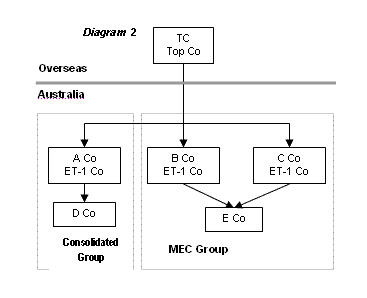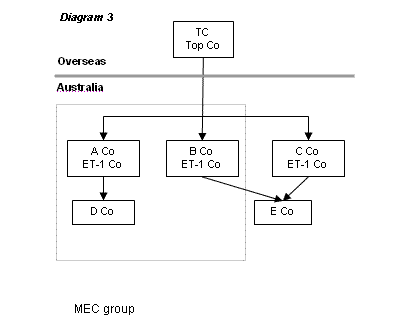Draft Taxation Determination
TD 2005/D6
Income tax: consolidation: membership: are the eligible tier-1 companies of a foreign-owned group required to form a single multiple entry consolidated group which includes all those eligible tier-1 companies?
-
Please note that the PDF version is the authorised version of this draft ruling.This document has been finalised by TD 2005/38.
FOI status:
draft only - for commentPreamble
| This document is a draft for industry and professional comment. As such, it represents the preliminary, though considered views of the Australian Taxation Office. This draft may not be relied on by taxpayers and practitioners as it is not a ruling for the purposes of Part IVAAA of the Taxation Administration Act 1953. It is only final Taxation Determinations that represent authoritative statements by the Australian Taxation Office. |
1. No, it is not necessary for all eligible tier-1 companies of a foreign-owned group to form a single multiple entry consolidated (MEC) group.
2. A MEC group is formed when two or more eligible tier-1 companies of a foreign company (the top company) make an irrevocable choice to consolidate a potential MEC group derived from those companies (section 719-50 and paragraph 719-5(1)(a) of the Income Tax Assessment Act 1997 (ITAA 1997)). A MEC group can also be formed as a result of a special conversion event happening to a consolidated group - section 719-5 and section 719-40 of the ITAA 1997.
3. For any foreign-owned group that has more than one eligible tier-1 company, several potential MEC groups may be identified (section 719-10 of the ITAA 1997). For example, if the group contains two eligible tier-1 companies, three potential MEC groups may be identified:
- •
- a potential MEC group consisting of the first eligible tier-1 company and its wholly-owned Australian subsidiaries, if any, meeting the condition in paragraph 719-10(1)(b) and (where applicable) subsection 719-10(2) of the ITAA 1997 (described for convenience in this Taxation Determination simply as 'wholly-owed Australian subsidiaries');
- •
- a potential MEC group consisting of the second eligible tier-1 company and its wholly-owned Australian subsidiaries, if any; and
- •
- a potential MEC group consisting of the two eligible tier-1 companies together and their wholly-owned Australian subsidiaries, if any.
Similarly, seven potential MEC groups may be identified in relation to a foreign-owned group that has three eligible tier-1 companies.
4. The provisions in the law governing the formation of consolidated and MEC groups allow a foreign-owned group flexibility to form one or more MEC groups, a series of consolidated groups or a combination of consolidated and MEC groups (where the group structure permits). The provisions also allow individual eligible tier-1 companies to remain outside any consolidated or MEC group.
5. Each of the potential MEC groups which can be identified within a foreign-owned group may individually consider the possibility of forming a consolidated group under section 703-50 of the ITAA 1997, or a MEC group under section 719-50 of the ITAA 1997 as appropriate. For example, a single eligible tier-1 company of the top company, if it has one or more wholly-owned Australian subsidiaries, may choose under section 703-50 of the ITAA 1997 to form a consolidated group from the potential MEC group consisting of itself and those subsidiaries. Alternatively, the eligible tier-1 company may join one or more other eligible tier-1 companies (but not necessarily all the eligible tier-1 companies of the top company) to form a MEC group under section 719-50 of the ITAA 1997. The MEC group would comprise the members of the potential MEC group made up of the eligible tier-1 company, the other eligible tier-1 companies, and each of their wholly-owned Australian subsidiaries. A single eligible tier-1 company without any wholly owned subsidiaries cannot, however, form a consolidated group on its own.
Example 1
6. XCo and YCo are eligible tier-1 companies of TC, the top company of a foreign-owned group. Neither XCo nor YCo have any subsidiaries. While three potential MEC groups may be identified within this group structure, neither XCo nor YCo may form a consolidated group in its own right. The only choice available to the corporate group under Part 3-90 of the ITAA 1997 as to consolidation is to form a MEC group consisting of XCo and YCo.
Example 2
7. MCo and NCo are eligible tier-1 companies of TC, the top company of a foreign owned group. OCo is a wholly owned subsidiary of NCo. MCo has no subsidiaries. As in Example 1, three potential MEC groups may be identified within this group structure. However, only two choices are available to the corporate group under Part 3-90 of the ITAA 1997 as to consolidation. First, NCo may choose to form a consolidated group with OCo as a subsidiary member. In this scenario, MCo will remain outside the group. Alternatively, the group consisting of MCo, NCo and OCo may together form a MEC group. MCo is not able to form a consolidated group in its own right.
Example 3
8. ACo, BCo and CCo are eligible tier-1 companies of TC, the top company of a foreign-owned group. ACo owns all of the membership interests in DCo. BCo and CCo jointly own all the membership interests in ECo.
Diagram 1 - If ACo, BCo and CCo make a choice to form a MEC group under section 719-50 of the ITAA 1997, DCo and ECo automatically join the MEC group as subsidiary members.

Diagram 2 - Alternatively, ACo can form a consolidated group with DCo. BCO and CCo can form a MEC group with subsidiary member ECo.

Diagram 3 - Alternatively, ACo and BCo can choose to form a MEC group with subsidiary member DCo. In this scenario, ECo would be unable to join this MEC group as it is not wholly owned by the eligible tier-1 companies that chose to form the MEC group. Further, CCo is unable to choose to form a consolidated group because it does not have a wholly owned subsidiary. Note: CCo is not able at some future date to choose to become part of the MEC group consisting of A Co, B Co and D Co as an eligible tier-1 company.

Date of Effect
9. When the final Determination is issued, it is proposed to apply both before and after its date of issue. However, the Determination will not apply to taxpayers to the extent that it conflicts with the terms of settlement of a dispute agreed to before the date of issue of the Determination (see paragraphs 21 and 22 of Taxation Ruling TR 92/20).
Your comments
10. We invite you to comment on this draft Taxation Determination. Please forward your comments to the contact officer by the due date.
| Due date: | 10 June 2005 |
| Contact officer details have been removed following publication of the final ruling. | |
Commissioner of Taxation
11 May 2005
Not previously issued as a draft
References
ATO references:
NO 2004/12062
Related Rulings/Determinations:
TD 2005/D8
TR 92/20
Subject References:
choice to form
consolidated group
consolidation
consolidation - formation
consolidation - membership
consolidation - multiple entry consolidated groups
eligible tier-1 company
foreign-owned group
potential MEC group
special conversion event
top company
Legislative References:
TAA 1953 Pt IVAAA
ITAA 1997 Pt 3-90
ITAA 1997 703-50
ITAA 1997 719-5
ITAA 1997 719-5(1)(a)
ITAA 1997 719-10
ITAA 1997 719-10(1)(b)
ITAA 1997 719-10(2)
ITAA 1997 719-40
ITAA 1997 719-50
